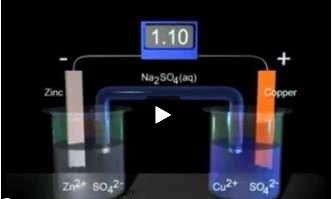CHEM 01LC Lecture Notes - Lecture 7: Standard Hydrogen Electrode, S.H.E, Salt Bridge

CHEM 01LC Experiment 7: Voltaic Cells
●Experimental purpose
○The purpose of this experiment is to calculate Ksp from cell potential and
concentrations obtained from observing voltaic cells
● Oxidation-Reduction Reactions
○Redox reactions: reactions characterized by electron transfer
■The oxidized species loses
electrons
●Occurs at the anode of electrochemical cells
■The reduced species gains
electrons
●Occurs at the cathode of electrochemical cells
○Electron flow from oxidized to reduced species produces electrical current that
can be used to do work
●Types of Electrochemical Cells
○Voltaic: produce electricity
○Electrolytic: use electricity to make nonspontaneous reactions go
●Components of a Voltaic Cell
○Electrolyte solutions: allows electric current to flow by ion migration
○Electrodes: pieces of metal immersed in solutions
○Metal wire: connects anode to cathode in separate solutions (half-cells
)
○Salt bridge: keeps current flowing by connecting half-cell solutions
■Anions are attracted to the anode, cations are attracted to the cathode
●Cell Diagrams
○Cell diagram: notation used to superficially describe a cell
■Anode | Ionic species (anode) || Ionic species (cathode) | Cathode
○Example: Fe | Fe2+ || Cu2+ | Cu
●Electrochemical Potentials
○Standard electron potentials: refer to the half reactions written as reductions
■Determined by comparison to the standard hydrogen electrode (S.H.E.)
Document Summary
The purpose of this experiment is to calculate k sp from cell potential and concentrations obtained from observing voltaic cells. Redox reactions : reactions characterized by electron transfer. Occurs at the anode of electrochemical cells. Occurs at the cathode of electrochemical cells. Electron flow from oxidized to reduced species produces electrical current that can be used to do work. Electrolytic : use electricity to make nonspontaneous reactions go. Electrolyte solutions : allows electric current to flow by ion migration. Electrodes : pieces of metal immersed in solutions. Metal wire : connects anode to cathode in separate solutions ( half-cells ) Salt bridge : keeps current flowing by connecting half-cell solutions. A nions are attracted to the a node, c ations are attracted to the c athode. Cell diagram : notation used to superficially describe a cell. Anode ionic species (anode) ionic species (cathode) cathode. Example : fe fe 2+ cu 2+ cu.


